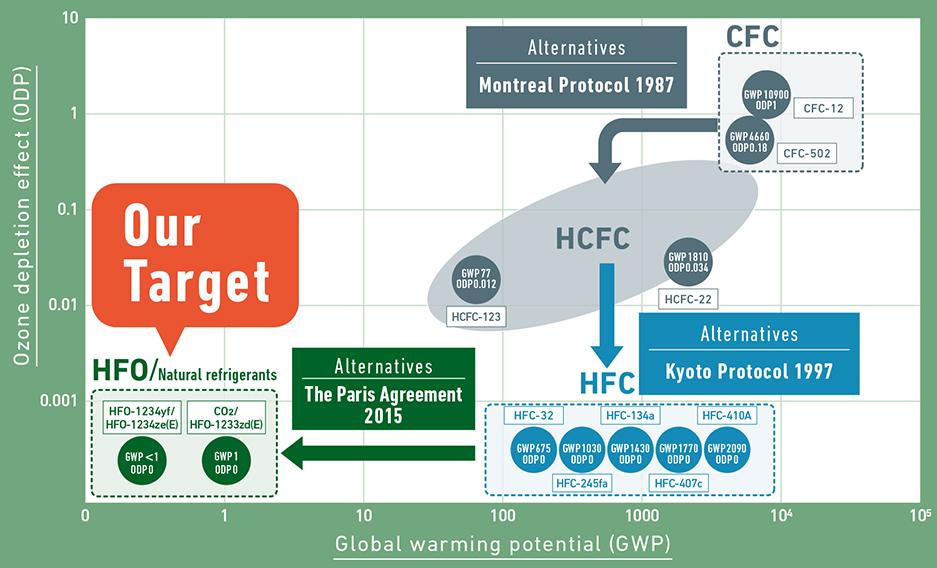ENVIRONMENT
Initiatives to Switch to Environmentally Friendly, Low-GWP*¹ Refrigerants
- 1GWP: Global warming potential
With the acceleration of global warming, there has been a worldwide demand for environmentally friendly, low-GWP refrigerants. With our advanced technologies in thermal systems, we strive to reduce CO2 emissions and actively implement environmental initiatives. This is an introduction to our initiatives in switching to low-GWP refrigerants.

Background behind the Initiatives
Global Acceleration in the Trend Toward Low-GWP Refrigerants to Eliminate Fluorocarbons and Realize Decarbonization
In the Kigali Amendment to the Montreal Protocol / Vienna Convention
adopted in 2016, in Rwanda, an agreement was reached on the specific
amounts by which the use of specified hydrochlorofluorocarbons (HCFC) and
alternative hydrofluorocarbons (HFC) would be reduced. This has resulted
in the need to switch to low-GWP refrigerants in stages.
In addition to international treaties, progress has been made by
individual countries through original policies to restrict the use of
refrigerants. For example, Japan adopted a system for designated products
in 2025 requiring all manufacturers to switch to low-GWP refrigerants. In
addition to government policies, private companies are decarbonizing
through policies of their own to eliminate fluorocarbons.

HFO:IPCC IPCC Fifth Assessment Report
Green Premiums Are Important, but There Is Also a Need to Pursue Economic Feasibility
Companies are examining ways to lower GWP through environmentally friendly
equipment and services, but there is also a limit to the premiums that can
be paid on environmental friendliness.
Promoting the use of environmentally friendly equipment requires
incentives based on government policies, such as subsidies reflecting the
amount by which global warming can be suppressed. It is the responsibility
of manufacturers to realize this by developing and marketing
high-efficiency thermal systems adapted to low-GWP refrigerants.
Our Solution to Keeping Up with the Times by Switching to Low-GWP Refrigerants
Our Philosophy
The need for environmentally friendly thermal solutions is spreading globally. Our company is contributing proactively to the preservation of the global environment by promoting decarbonization through our advanced technologies.
Achievements
1.Chillers
1-1.Our History and Achievements in Developing Low-GWP Refrigerants
MITSUBISHI HEAVY INDUSTRIES THERMAL SYSTEMS,LTD.(MTH) has always taken great care to be environmentally friendly, and has strived to be a pioneer in innovative technologies. We have a track record of having developed and launched freezers using low-GWP refrigerants (HFO-type refrigerants) in the 2000s when the technology was still new. Specifically, we launched freezers using HFO-1233zd (GWP=1) in September 2016, and HFO-1234ze (E) (GWP<1) in April 2017.


Our entire conventional HFC-type series was switched to the new
refrigerant. This boosted the freezing capacity from 150USRt to 5000USRt,
and from small-capacity to large-capacity products, realizing low-GWP
refrigerant centrifugal chillers across our entire lineup.
Today, we continue our efforts to shorten developmental intervals as much
as possible in launching new series of low-GWP products.
1-2.The Developmental Concept behind Low-GWP Refrigerators
In choosing refrigerants, we give consideration to not only their GWP, but also their safety and availability. Low-GWP refrigerants have greater gas volume compared to conventional refrigerants, which tends to increase the size of refrigerators when using normal designs. MTH uses technologies in, e.g., CFD analysis to optimize the shapes of compressors and heat exchangers, realizing compact designs. On the other hand, they perform just as well as conventional refrigerators.
2.Heat pumps and Freezers for ultra low temperature
2-1.History and achievements in developing heat pumps and freezers for ultra low temperature
Our company develops ecofriendly heat pumps and freezers that use CO2
as a refrigerant
Our commercial heat pump water heater, Q-ton was launched in October 2011,
and the freezer C-puzzle, a refrigerated condensing unit with CO2
refrigerant, was launched in November 2017.


While CO2 is an environmentally friendly refrigerant with a GWP
of 1, CO2 can also provide excellent performance in instantly
heating cold water to hot water for heat pump water heaters.
CO2 also plays a key role in our freezers that operates where
there is a large temperature difference between the freezer/refrigerator
and the ambient temperature.
2-2.The concept for developing our heat pumps and freezers
We have succeeded in developing the world's first two-stage compressor, the ""Rotary and Scroll Compressor,"" and by combining it with the gas injection, we have improved the overall performance of the compressor. This enables the Q-ton to operate at the low ambient temperature of -7 degrees Celsius without the loss of heating capacity, while for C-puzzle playing a significant role in achieving high efficiency in a wide operating range from freezing (-45 to -15 degrees Celsius) to refrigeration (-15 to -5 degrees Celsius)."

Our Future Initiatives to Promote the Deployment of and Switch to Environmentally Friendly Equipment
There is also a need to deal with products already on the market (already in use). For example, we are considering the retrofitting of equipment with refrigerants (switching refrigerants). Current laws on refrigerants in Japan hinder the ease of retrofitting. MTH is negotiating with the relevant organizations to cooperate in the laying down of new guidelines and laws.
Currently, heat pumps are being applied to use for below 100 degrees Celsius, however, we plan to consider applying heat pumps to areas above 100 degrees Celsius. In addition, we expect the market trend to shift from gas boilers to heat pumps, and by expanding the range of temperatures and capabilities that heat pumps can be applied to, we will expand the applications and contribute to achieving carbon neutrality.
We will also contribute to the preservation of the global environment by developing high-performance products that use even lower GWP refrigerants. We will strive to replace conventional refrigerants, while simultaneously boosting performance by using the cutting-edge technologies of the Mitsubishi Heavy Industries Group cultivated over the years.
